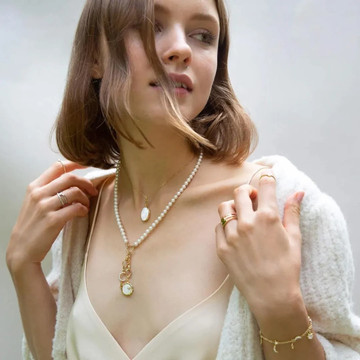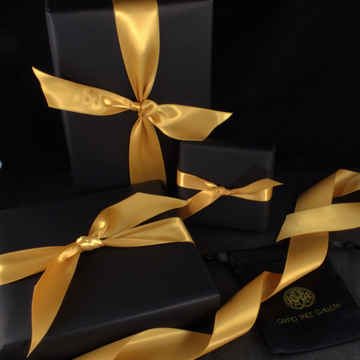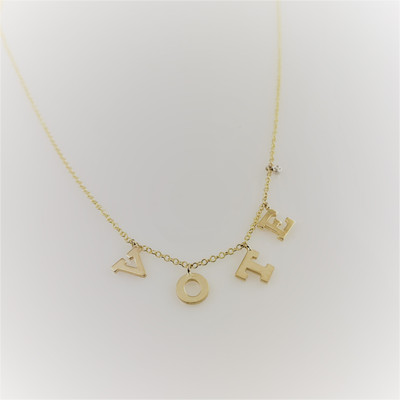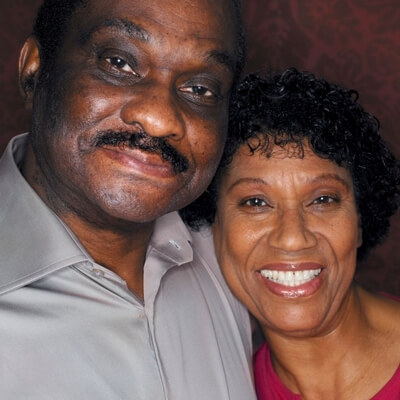Let’s talk about jewelry that empowers, jewelry that resonates, jewelry that makes a difference.
There are several reasons that we choose to wear jewelry. Some pieces we wear in order to make us feel more put together, some things we wear to feel more beautiful, some things we wear simply to make an outfit pop, and others still we simply never take off. Maybe it’s a combination of those things, but there is another type of jewelry - jewelry that empowers; not just you, but others around you too.
Jewelry with purpose is far more than something you throw on just because. It carries a message that inspires and has the power to make a real difference.
For example, you probably noticed the excitement surrounding Michelle Obama’s “vote” necklace that she wore during her keynote speech at the Democratic National Convention a few weeks ago. It just so happened that this time around it was Michelle Obama, but the subtle but powerful message - to vote - broke through because of the way it was presented. Subtle, but important. The piece needn’t be viewed as a statement of support for one particular party over another, it was simply a new and beautiful way to encourage people to participate in their Republic. This is a perfect instance of jewelry being worn with purpose. Presented subtly, delicately, with a bit of a twinkle on the neck, all of a sudden voting seems a little more exciting! Sometimes we just need that little nudge of something sparkly, or a bandwagon to jump on in order to find our feet and our own voice (ironically).
Exercising your civic duty, voting and encouraging other people to do the same, is often met with the rolling of eyes or a huff of frustration. It would seem that voting has not been considered the most snazzy thing, it often gets seen as “too political” and thrown in with the divisive nature of current political discourse that many people choose to cordon themselves off from. The problem with that is that voting is actually the most effective way of changing that discourse.
When you cast a ballot in any election you are using the substantial power of your citizenship to help form a government that is more perfect from your individual standpoint. In your vote is the power to defend the defenseless, protect the vulnerable, enfranchise the disenfranchised, to literally alter the priorities of a nation - it is an awesome responsibility that just over half of the citizens of this country choose to exercise.
 Voting is a solemn privilege with a fraught history of discrimination and exclusion. When the United States was first formed as 13 colonies the Constitution did not actually define who was able to vote, it was left to each state to decide. In the early days of this Republic, suffrage lay solely in the hands of white men with property, indeed at the time Black Americans were not even regarded by the Constitution as whole people. It took decades of demonstrations by thousands of voting rights activists, community leaders, and dedicated jurists in order to get us to where we are today.
Voting is a solemn privilege with a fraught history of discrimination and exclusion. When the United States was first formed as 13 colonies the Constitution did not actually define who was able to vote, it was left to each state to decide. In the early days of this Republic, suffrage lay solely in the hands of white men with property, indeed at the time Black Americans were not even regarded by the Constitution as whole people. It took decades of demonstrations by thousands of voting rights activists, community leaders, and dedicated jurists in order to get us to where we are today.
THE FIGHT FOR SUFFRAGE
Women have historically voted in higher numbers than men in midterm and presidential elections, more women than ever are running for and winning city, county, state, and federal elections, and women have emerged as a massive fundraising force in modern elections. It thus feels appropriate to take a moment to talk about the passage of the Nineteenth Amendment and the enfranchisement of women.
Women were not allowed to vote in the United States until 1920, after more than eight decades of campaigning spearheaded by the likes of Susan B. Anthony, Alice Paul, Elizabeth Cady Stanton (left), Lucy Stone, Ida B. Wells, Frances E.W. Harper and Mary Church Terrell. They certainly did not agree on all elements or strategies for gaining the vote, but they were united in their certainty that women should be allowed to do so.
 It was 1840 when Elizabeth Cady Stanton was refused entry to the World Anti-Slavery Convention in London because she was a woman. This event would be the catalyst that would start her career as a women’s rights activist, convinced that women deserved a seat at the table. The first Women’s Rights Convention was held in 1848 where Cady Stanton unveiled “The Declaration of Sentiments,” a document that would become the playbook for women’s activism for decades.
It was 1840 when Elizabeth Cady Stanton was refused entry to the World Anti-Slavery Convention in London because she was a woman. This event would be the catalyst that would start her career as a women’s rights activist, convinced that women deserved a seat at the table. The first Women’s Rights Convention was held in 1848 where Cady Stanton unveiled “The Declaration of Sentiments,” a document that would become the playbook for women’s activism for decades.
Over the next four decades women activists attempted to pressure the federal government and state governments to pass women’s suffrage through conventions, speeches, and campaigns of protest and civil disruption. It wasn’t until 1890 and the ushering in of the Progressive Era that real headway began to be made as more and more women entered public life. Their roles in society expanded, and as such their fight for suffrage and equal rights became a part of the political mainstream.
By 1912 the Movement had found support in a major political party for the first time, Theodore Roosevelt’s Bull Moose Party. That same year more than 20,000 suffrage supporters attended the New York City suffrage parade. That same parade swelled to 40,000 attendees by 1915. 1916 saw the first woman elected to Congress, Jeannette Rankin of Montana and Woodrow Wilson made support of suffrage an official part of the Democratic Party platform.
As a last ditch effort to undermine the Movement, National Woman’s Party (NWP) picketers were arrested on charges of obstructing sidewalk traffic during their protests in June 1917, and were sentenced to 6 months in prison. The leader of the party, Alice Paul (below, left), was placed in solitary confinement in an attempt to sully her reputation and break her resolve. But the public was on their side. When NWP inmates began a hunger strike to protest their unfair and inhumane treatment, news of their being force fed for weeks, and of Paul’s placement in solitary led to enormous public outcry and by November all the NWP inmates were released.

By 1918 the proposed amendment for women’s suffrage passed the House, but failed in the Senate leading to President Wilson publicly throwing his support behind the Movement. He further addressed the Senate about the adoption of the Nineteenth Amendment, which finally passed in 1919 and was ratified by three quarters of state legislatures by 1920, finally securing the vote for all American women.
So we see through this history what it really means to vote. If your vote was so unimportant, then why did it take decades to get it? Why is it still being threatened to be taken from you? There are presently many notable improvements to be made in areas of post release re-enfranchisement, gerrymandering, and voter-suppression, and the best way to secure those rights for others is to VOTE for the people who will make the necessary changes and fight to make it right.
MORE THAN JUST JEWELRY
The above is but one case of how a piece of jewelry can move someone to action, but there are countless others that have nothing to do with government. At Giving Tree Gallery we are proud to carry hundreds of pieces that boast messages of encouragement, support, and inspiration. We enjoy providing the pieces that you reach for that strengthen your resolve, boost your confidence, change your perspective, or that can be given as motivational gifts to others so they might do the same for them.
Take for instance our collection of Kathy Bransfield or Chocolate and Steel pieces, that offer comfort and inspiration from the death of a loved one to the joys of motherhood, from bouncing back after failure to celebrating successes. These are all pieces that serve a point far beyond simply looking good with your favorite sweater (though they do that too - they’re multifaceted in that way).
When you are having a tough day there is something to be said for donning a piece that carries a message of warmth and comfort. If you’re heading in to take a test or a tough meeting, wearing a bracelet that instills confidence and resolve is the perfect thing to be able to glance down at. If you’re feeling stuck, a necklace that supports you chasing your dreams is a wonderful pick-me-up. This is the role of jewelry that empowers.
These pieces can be carried as talismans through life's many ebbs and flows. They allow us to learn important lessons by proxy from some of history’s most storied thinkers, artists, visionaries, and scientists. Imagine getting a word of encouragement from Cervantes before you begin your dissertation, or a message from Einstein as you muddle through a challenging week!
ENCOURAGEMENT FOR EVERYONE
Another benefit of these pieces is that they mean something different to everyone. Inspiration pieces, pieces that call people to action, are always open to interpretation. That is part of their great benefit, why they are so popular, and why they are a trend that never goes out of style.
They are not simply for one person, when you wear a bracelet or necklace like this you are the walking embodiment of the piece you have chosen. It helps instill the message in you, becomes an affirmation as you go about your day. But it’s more than that. Someone you pass on the street may catch a glimpse of your piece and find encouragement too! You may wear a piece that another person sees as the sign that allows them to take a leap of faith, or see the light after being drowned in darkness.
If you are looking to push yourself, to inspire someone else, to show support, kindness, gratitude, love, guidance, joy, solemnity, devotion, any and all of these, or even more, these jewelry pieces that empower are the perfect place to start. There are few things that can provide the same powerful affirmations in such a small package that can be carried with you (or someone else) daily.
There is so much power in what we choose to don each and every day. We make strong statements with our clothing, our bags, our hairstyles - we can and should say the same about our jewelry!
Political Themed Empowering Jewelry | Givingtreegallery.com




























